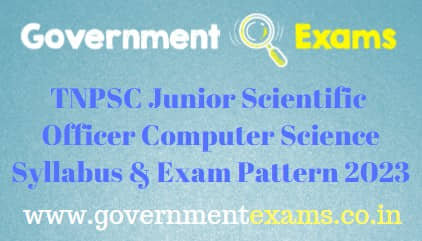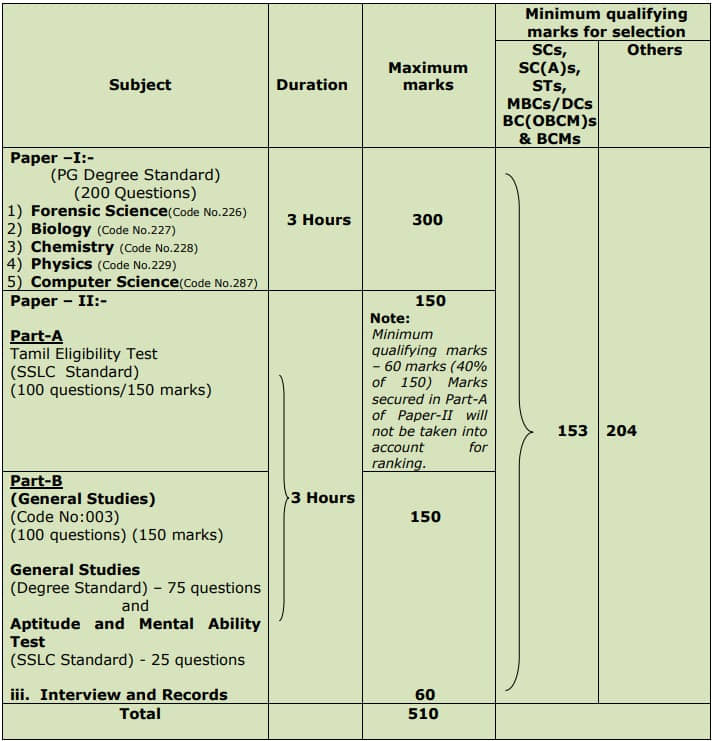TNPSC Junior Scientific Officer Computer Science Syllabus and Exam Pattern 2023:
Tamil Nadu Public Service Commission (TNPSC) has given an employment notification for the recruitment of 31 Junior Scientific Officers in the Tamil Nadu Forensic Sciences Subordinate Service. Candidates with an M.Sc. Degree in a relevant stream looking for TNPSC Junior Scientific Officer check the Official notification @ www.tnpsc.gov.in or you can see it below. Eligible candidates can apply online directly and also see the TNPSC JSO CS Exam Pattern, Syllabus, Education Qualification, Selection Process, and Important details below. Check the complete TNPSC JSO Computer Science Syllabus available both in Tamil & English before preparing for Written Examination(CBT). See TNPSC JSO Computer Science Syllabus 2023 and Exam Pattern below:
TNPSC JSO Paper I Syllabus for Computer Science – questions based on PG Degree Standard. TNPSC JSO Paper II Syllabus is based on Tamil Eligibility Test & General Studies. Check the complete JSO Computer Science Syllabus below both in text and in PDF format. Interested candidates check the complete syllabus and exam pattern of JSO below and also download the same. See the TNPSC JSO CS Exam Pattern and Syllabus PDF Tamil and English below:
To see the complete Notification of TNPSC JSO Recruitment, check the link – TNPSC JSO Recruitment 2023
TNPSC JSO Computer Science Exam Pattern:
TNPSC JSO Computer Science Selection is based on a Written Examination (Objective Type) (Computer Based Examination)
– Written Examination is of Paper-I: Computer Science (PG Degree Standard) and Paper-II: Part A (Tamil Eligibility Test) & Part B (General Studies)
Junior Scientific Officer Paper I Computer Science Syllabus PDF:
The complete CS syllabus for JSO in Tamil and English is given below. See the full TNPSC JSO Paper I Syllabus below:
Paper I – Syllabus: Computer Science (PG Degree Standard)
UNIT – I: MATHEMATICAL FOUNDATIONS
AUTOMATA, LANGUAGES, AND COMPUTATION Basic concepts of strings, alphabets, languages, finite automaton, regular expressions, Moore and Mealy machines, regular sets, minimization of finite automata, Chomsky hierarchy of languages, the relation between classes of languages, context-free grammar, pushdown automata, Linear bounded automata, Turing machines, halting problem and decidability.
DESIGN AND ANALYSIS OF ALGORITHMS Design Techniques, divide and conquer, greedy method, dynamic programming, etc., graph algorithms, Strassen’s matric multiplication algorithm, geometric algorithms, NP-complete problems, approximation algorithms.
UNIT – II: COMPUTER ARCHITECTURE
Review of elements of Computer organisation – Machine instructions, addressing modes, instruction pipelining, memory organization. CPU and system buses, bus standards, Von Neumann Vs Non-Von Neumann architectures, language-directed architectures, RISC architectures, object-oriented architectures, memory and I/O subsystems – Hierarchical memory, virtual memory system memory allocation, and management, cache memories, I/O subsystems, architectural classification, pipelined processors, vector processing. Array processors, multiprocessor architectures.
UNIT – III: DATA STRUCTURES IN C++
Data types, control statements, procedures, Scope rules, arrays and records, enumerated datatypes, sets, pointers, and recursion. Sequential, indexed files, sorting and merging report generations. Arrays, queues, linked lists, stacks, tree traversal, evaluation of expressions using postfix notation, sorting algorithms, bubble sort, quick sort, heap sort, and complexity of algorithms.
UNIT – IV: COMPILERS AND ADVANCED OPERATING SYSTEMS
Assemblers loaders, linkers, macro processors, text editors, programming languages, lexical analysis, parsing techniques, precedence grammars, symbol tables, scope rules and parameter passing mechanisms, syntax-directed translation, run time environment, machine code generation, and interpreter.
ADVANCED OPERATING SYSTEMS
(a) Review of uniprocessor operating system: Batch, multiprogramming and time-sharing systems, operating system concepts, memory, device and file management, process scheduling, interprocess communication, process synchronization and concurrency, deadlocks, protection.
(b) Multiprocessor operating system: Classification of multiprocessor operating systems, software and operating system requirements for multiprocessors, multiprocessor scheduling strategies.
(c) Distributed Operating System: Communication in distributed systems, client-server model, remote procedure call, group communication, synchronization in distributed systems, mutual exclusion and election algorithms, deadlocks in distributed systems, processor allocation algorithms, scheduling in a distributed system, distributed file systems
UNIT – V: DATABASE MANAGEMENT SYSTEMS
Elements of database systems, file organization, relational and network data models, normal forms, and query languages. Design and implementation of typical database systems, Internal and external consistency, concurrency control techniques, and object-oriented databases.
UNIT – VI: MOBILE COMMUNICATIONS
Mobile IP: Goals – Packet Delivery – Strategies – Registration – Tunneling and Reverse Tunneling – Adhoc Networks – Routing Strategies. WIRELESS APPLICATION PROTOCOL [WAP] – Architecture – XML – WML Script – Applications.
UNIT – VII: SOFTWARE PROJECT MANAGEMENT
Software Project Planning: Size Estimation – Cost Estimation Models – The Constructive Cost Model (COCOMO)-COCOMO II – The Putnam Resource Allocation Models -Software Risk Management.
UNIT – VIII: MULTIMEDIA AND WEB TECHNOLOGIES
Uses of Multimedia – Introduction to making multimedia – Multimedia skills. Multimedia hardware and software – Connections – Memory and storage devices – Input devices – Output devices – Communication devices. Basic software tools – Text editing and word processing tools – Painting and drawing tools – 3-D modeling and animation tools – Image editing tools – Animation, video and digital movie tools. Making instant multimedia – Multimedia authoring tools. Multimedia Building Blocks – Text – Sound Multimedia System Sounds – MIDI versus Digital Audio – Digital Audio – Making MIDI Audio – Audio File Formats – Production tips – Images – Animation – Video.
The world wide web: Browsing the Web – Web address – Web browser basics – Strong and managing(bookmarks) – Surfing the web with web browser – Searching the web directory – Search engines – Navigation tools.
Email: Sending – Reading – Replying – Deleting – Exiting – Sending Mail to more than one person sending folder – Forwarding a mail – Checking the spelling – Attachments.
HTML: Overview of HTML – Adding structure to a page formatting text and pages – Linking page to the world – Including pictures – Clearing lists – Arranging items within tables – Getting feedback from form – Splitting a page into frames.
UNIT – IX: OBJECT-ORIENTED ANALYSIS AND DESIGN
Unified Modeling Language [UML] – Diagrams – Class – Use case – Naming Classes – Identifying Objects, Relationships, Attributes, Methods – Association – Super and Sub Class Relationship – Aggregation.
UNIT – X: ADVANCED TOPICS: ARTIFICIAL INTELLIGENCE, CLOUD COMPUTING, CYBER SECURITY
Artificial Intelligence: Production systems, different strategies, hill climbing, backtracking, graph search specialised production systems, minimax procedure, alpha-beta pruning, resolution and refutation, control strategies, structured representation of knowledge, semantic nets, frames.
Cloud Computing: Architecture – Deployment Models – Application Virtualization – Hardware Virtualization.
Network Security: Potential Attacks to Computer System – Cryptography – Authentication – Access Control – Digital Signatures.
TNPSC Junior Scientific Officer Paper II Syllabus:
Part A: கட்டாயத் தமிழ்மொழித் தகுதித் தேர்விற்கான பாடத்திட்டம் (கொள்குறிவினாவிற்கான தலைப்புகள்)
பத்தாம் வகுப்புத் தரம்
Part B: General Studies (Degree Standard)
(Topics for Objective Type)
1. General Science
2. Current Events
3. Geography
4. History and Culture of India
5. Indian Polity
6. Indian Economy
7. Indian National Movement
8. History, Culture, Heritage, and Socio-Political Movements of Tamil Nadu
9. Development Administration in Tamil Nadu
10. Aptitude & Mental Ability Tests
To see the complete TNPSC Junior Scientific Officer Computer Science Paper I & Paper II Syllabus PDF Download, check the link – TNPSC JSO Computer Science Syllabus PDF
To see other subjects TNPSC JSO Syllabus and Exam pattern 2023, check the link – TNPSC JSO Syllabus and Exam Pattern 2023


